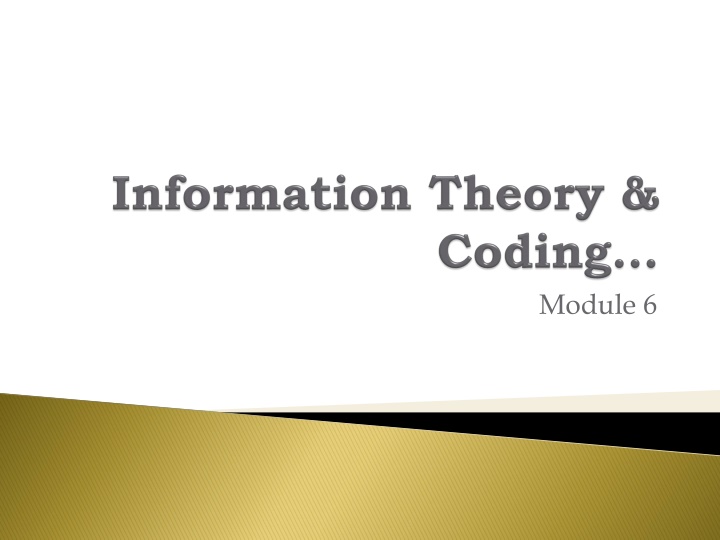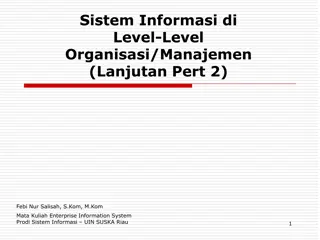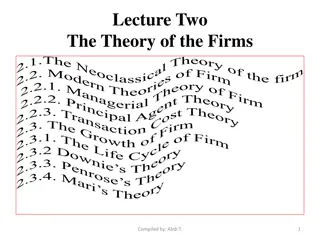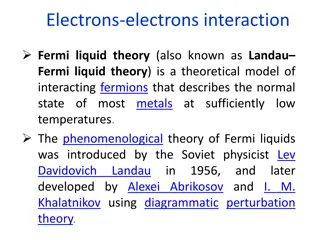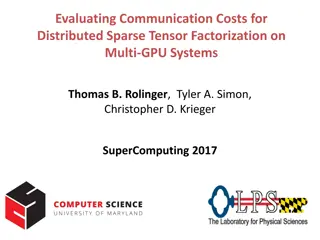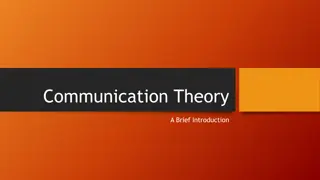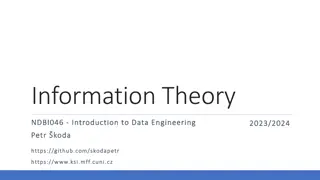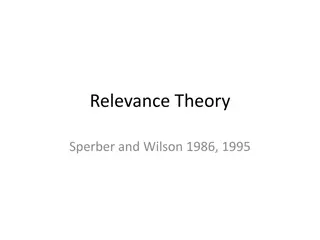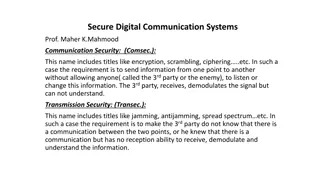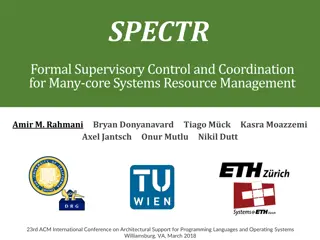Importance of Information Theory in Communication Systems
Information theory, pioneered by C.E. Shannon in the late 1940s, focuses on data compression, entropy, coding techniques, transmission rates, and channel capacity. It helps determine the amount of information in a signal, compression limits, and optimal transmission rates over noisy channels. Shannon's work established fundamental concepts like entropy, channel capacity, and error rates in communication systems with discrete memory-less sources.
Download Presentation

Please find below an Image/Link to download the presentation.
The content on the website is provided AS IS for your information and personal use only. It may not be sold, licensed, or shared on other websites without obtaining consent from the author.If you encounter any issues during the download, it is possible that the publisher has removed the file from their server.
You are allowed to download the files provided on this website for personal or commercial use, subject to the condition that they are used lawfully. All files are the property of their respective owners.
The content on the website is provided AS IS for your information and personal use only. It may not be sold, licensed, or shared on other websites without obtaining consent from the author.
E N D
Presentation Transcript
What is information and how its important. What is data compression it s aspect; entropy. Some coding techniques. Data transmission through channel and its reception our goal to achieve.
Invented by C.E. Shannon in late 1940s. Information theory deals with mathematical modeling and analysis of a communication system rather than physical sources and channels. In particular it helps us to find The amount of information contained in the signal. The irreducible complexity below which the signal cant be compressed. The ultimate transmission rate for reliable communication over a noisy channel.
Information theory answers two fundamental questions: What is the ultimate data compression? Answer: The Entropy H. What is the ultimate transmission rate? Answer: Channel Capacity C. The concept that increasing transmission rate over a channel increases the error rate. Shannon showed that this is not true as long as rate is below Channel Capacity. Shannon has further shown that random processes have an irreducible complexity below which they can not be compressed.
We assume a discrete memory less source , memory less in the sense that the symbol emitted at any point of time is independent of previous choices. The source output as emitted during every signaling interval is modeled as a discrete random variable, S, which takes on symbols from a fixed finite alphabet with probabilities P(S=sk) = pk k =0,1,2,3 .. and = 0 k = { , , ... } s s s K s 0 1 2 1 1 K = 1 k p
For an event S = sk with the symbol sk emitted by the source with probability pk. Then if pk=1 and pi = 0 and for all , then there is no information because we know what the message is going to be from the source. i k But if pk is low, then there is more surprise and so the information when sk is emitted by the source than the symbol si which is having the higher probability to be emitted. The amount of information is related to the inverse of the probability of occurrence as given by ) ( k s I = 1 p = log( ) log( ) p k k
So, ( ) ( ) I s I s k i for p p k i When pk=1/2, we have I(sk)=1, i.e., one bit of information that we gain when one of two possible and equally likely events occur. And ( ) 0 ; 0 1 I s p k k
The amount of potential information contained is a signal is termed the entropy, usually denoted by H, which is defined as follows: We can essentially think of this as a weighted average of log 1/P(X) . The quantity 1/P(X) expresses the amount of surprise in an event X i.e., if the probability is low, then there is a lot of surprise, and consequently a lot of information is conveyed by telling you that X happened. It s a measure of the average information content per source symbol. The reason we are taking the log of the surprise is so that the total amount of surprise from independent events is additive. Logs convert multiplication to addition, so .
Thus, entropy essentially measures the average surprise or average uncertainty of a random variable. If the distribution P(X) is highly peaked around one value, then we will rarely be surprised by this variable, hence it would be incapable of conveying much information. If on the other hand P(X) is uniformly distributed, then we will be most surprised on average by this variable, hence it could potentially convey a lot of information.
Properties of Entropy (P1) H(x) 0 p(x) 1 log [ 1/p(x) ] 0 [E] x = 1 p 0 1-p H(x) = - p log p (1-p) log(1-p) = H(p) the entropy function. 0 INFORMATION THEORY 11
Limiting factor: Entropy is 0, if and only if pk=1 for some k and remaining probabilities in the set are all 0 this means there is no uncertainty in the information. Entropy is log2 K, if and only if pk=1/K for all k i.e., all the symbols in the alphabet are equi-probable; this upper bound on entropy corresponds to maximum information.
We often use blocks rather than individual symbols, with each block consisting of n successive source symbols. This block could be viewed as an extended source with a source alphabet that has distinct blocks, where K is the no of distinct symbols in the source alphabet of the original source. n n K In case of a discrete memory less source, the source symbols are statistically independent.
Hence the probability of the source symbol in is equal to the product of the probabilities of the n source symbol in consisting of the particular source symbol in . We may thus expect that the entropy of the extended source is equal to n times the ). ( or n n H n= ( ) ( ) H nH
Consider a discrete memory less source with source alphabet with respective probabilities p0= ; p1= & p2 = . = { , , } s s s 0 1 2 The entropy of the source becomes log ) ( 2 0 = p H 1 p 1 p 1 p + + ( ) log ( ) log ( ) p p 1 2 2 2 0 1 2 1 1 1 = + + log ) 4 ( 2 log ) 4 ( 2 log ) 2 ( 2 4 4 2 3 = 2
For the second order extension of the source with the original source consisting 3 symbols the extended second order source will consists of 9 symbols as given by ; ; ; 2 0 2 1 0 1 0 0 0 s s s s s s = = = = = = = = = ; ; ; s s s s s s s s s s s s 3 1 0 4 1 1 5 1 2 ; ; ; 6 2 0 7 2 1 8 2 2 with their probabilities given as 1 0 = 1 1 1 1 = = = = ; ; ; ; 1 2 3 4 16 16 8 16 16 1 1 1 1 = = = = ; ; ; 5 6 7 8 8 8 8 4
So the entropy of the extended source is log 16 16 8 1 = 2 ( ) ( ) log H p 2 i ( ) p = 0 i i 1 1 1 1 1 = + + + + + log 16 ( ) 16 ( ) log ) 8 ( 2 log 16 ( ) log 16 ( ) 2 2 2 2 8 16 16 1 1 1 1 + + + log ) 8 ( 2 log ) 8 ( 2 log ) 8 ( 2 log ) 4 ( 2 8 = 8 8 4 3 , so = 2 ( ) 2 ( ). H H
If a source of massage generates messages at the rate r messages per second then then information rate is defined as R= rH = average no of bits of information / second. where, H stand for entropy of the source.
A binary symmetric channel (or BSC) is a common communications channel model used in coding theory and information theory. In this model, a transmitter wishes to send a bit (a zero or a one), and the receiver receives a bit. It is assumed that the bit is usually transmitted correctly, but that it will be "flipped" with a small probability (the "crossover probability"). This channel is used frequently in information theory because it is one of the simplest channels to analyze. (source: wikipedia)
From a transmitters point of view data of the source is compressed in a source encoder. For efficient compression we need the knowledge of entropy or the statistics of the source. For an example, we can assign short code to frequent source codes and longer code to infrequent one this is called variable length code.
The primary requirement for a efficient source encoder is that The code words produced by the encoder is in binary form. The source code is uniquely decodable, so that the original source sequence can be reconstructed perfectly from the encoded binary sequence.
We have the following source encoder Discrete Memory less Source Source Encoder Sk bk Binary sequence the above source is having an alphabet with K different symbols and k th symbol sk occures with probability pk, k=0,1,2,3 K-1. let the binary codeword assigned to symbol sk by the encoder have length lk, measured in bits.
So the average codeword length of the source encoder as = 0 k L 1 K = L p kl k in physical terms it represents the average no of bits per source symbol. if Lmin the minimum possible value for , then coding efficiency of the source encoder is given by- Lmin = L L L L with we have . encoder is said to be efficient when efficiency approaches unity. 1 min
Shannons first theorem on coding efficiency gives the idea to calculate .It is stated as Given a discrete memory less source of entropy , the average codeword length for any distortion less source coding scheme is bounded as ) ( H L L min ( ) H L So, according to the source coding theorem, the entropy represents a fundamental limit on the average no of bits per source symbol necessary to represent a discrete memory less source in that it can be made as small as, but no smaller that the entropy, so with , H ( = = ( ) L H min ) L
For efficient transmission redundant data should be removed from the signal prior to transmission. This operation with no loss of information is performed in digital form and is called as data compaction or lossless data compression. This operation provides the source output with average no of bits/symbol and also original data could be reconstructed from these data with no loss of information. So short descriptions are provided to the most frequent outcomes and longer for the less frequent ones.
Any sequence made up of the initial part of the code is called the prefix of the code and A Prefix Code is defined as a code in which no code word is the prefix of any other code word. Example of Prefix Code: Source Symbol Probabi lity Code I Code II Code III s0 s1 s2 s3 0.5 0.25 0.125 0.125 0 1 00 11 0 10 110 111 0 01 011 0111
Code I : its not a prefix code since the bit 0, the codeword for s0, is a prefix of 00 (s2). Again the bit 1, the codeword for s1 is the prefix of 11 (s3). Code III: its also not a prefix code. Justify Code II: it s a prefix code for the given condition that no code is the prefix of any other.
The important property of this code is that its uniquely decodable. To decode a sequence of code words generated from a prefix source code, the source decoder starts at the beginning of the sequence and decodes one code word at a time. This way it sets up a decision tree which is a graphical portrayal of code words in the particular code.
The first received bit moves the decoder to the terminal state s0, if its 0, or else to a second decision point if its 1. In the latter case, the second bit moves the decoder one step further down the tree, i.e., either to s1 if its 0 or to a third decision point if its 1. and so on .. Once each terminal state emits its symbol the decoder goes back to its initial state. The end of the prefix code is always recognizable. Hence, decoding could be accomplished as soon as the binary sequence representing the source symbol is fully received. So its also called the instantaneous code.
s0 0 s1 initial state 1 0 s2 1 0 1 s3
Decode the sequence 1011111000 and verify it will produce s1s3s2s0s0
we can prove 1 n = lim ( ) L H n n So, by making the order n of an extended prefix source encoder large enough, we can make the code faithfully represent the discrete memory less source as close as desired. In other words the average code word length of an extended prefix code can be made as small as the entropy of the source provided the extended code has a high enough order. But the disadvantage of extended code is increased decoding complexity.
Its one important class of prefix code. The basic idea behind the Hoffman coding is to assign to each of an alphabet a sequence of bits roughly equal to the amount of information conveyed by it. The end result is a source code whose average code word length approaches the fundamental limit set by the entropy of the memory less source namely entropy.
For given set of symbols with different probabilities there is a reduction process applied here to generate the code. The reduction process is continued in a step by step manner until we are left with a final set of two source symbols and they are assigned with 0 and 1. From this trivial last stage we then go back to the original symbol to find its code word.
The source symbols are listed in order of decreasing probability. The two source symbols of lowest probability are assigned a 0 and a 1 this is the splitting phase. These two source symbols are regarded as being combined to form a new source symbol with probability equal to the sum of two original probabilities (thus it in effect reduces the no of source symbols by one). This probability value of the new symbol is placed in the list according to its value. This process is continued until we are left with a final list of source symbols of only two for which we assign 0 and 1.
symbol Stage I Stage II Stage III Stage IV S0 0.4 0.4 0.4 0.6 --- 0 S1 0.2 0.2 0.4 --0 0.4 ---- 1 S2 0.2 0.2 -- ---0 0.2 -- 1 S3 0.1 ------- 0 0.2 ------ 1 S4 0.1 -------- 1
Symbol s0 s1 s2 s3 s4 Probability 0.4 0.2 0.2 0.1 0.1 Code word 00 10 11 010 011
average codeword length is therefore ) 2 ( 2 . 0 ) 2 ( 4 . 0 = = + ) 2 ( 2 . 0 + ) 3 ( 1 . 0 + ) 3 ( 1 . 0 + L 2 . 2 1 1 1 and entropy = 2 . 0 + 2 . 0 + + ( ) 4 . 0 log ( ) log ( ) log ( ) H 2 2 2 4 . 0 2 . 0 2 . 0 1 1 1 . 0 + 1 . 0 log ( ) log ( ) 2 2 1 . 0 1 . 0 = 46439 . 0 + 46439 . 0 + 33219 . 0 + 33219 . 0 + 52877 . 0 = 12193 . 2 H ( L ) efficiency - = = = 1293 . 2 2 . 2 / 9678 . 0
At each splitting level, there is arbitrariness in the way a 1 or a 0 is assigned to the last two source symbols. Ambiguity arises when the probability of a combined source is found to be equal of another probability in the list. We may place the new symbol as high as possible alternatively, it could be as low as possible.
Noise is omnipresent in any communication system mostly we consider it at the channel part. Depending on the level of noise the probability of error can increase or decrease thus affecting reliability of the transmitted signal. Design goal of a channel encoding is to increase the resistance of the communication to channel noise. So it consists of mapping the incoming data stream into a channel input sequence and inverse mapping the channel output sequence into an output data sequence in such a way to minimize the effect of channel noise.
We will use block code for channel coding concept. Features of block code The message sequence is subdivided into sequential blocks of k bits long. This k bit block is mapped into a n bit block where n > k. The no of redundant bits, added by the channel encoder to each transmitted block is given by (n-k). The ratio k/n is called the code rate, r. and its always less then 1. For a given k, the code rate r (and thus the system coding efficiency) approaches zero when block length, n approaches infinity.
For accurate reconstruction of the original source sequence it needs the average probability of signal error is zero. So our requirement is to find a coding scheme so that probability that a message bit is in error is very small and yet the code rate is not too small. Shannon s second theorem plays a important role in finding the answer for the requirement.
Suppose we have a source with entropy H bits per source symbol and the source emits symbols once every Ts seconds. Hence average information rate is H/Ts bits/second. The decoder delivers the decoded symbols at the same rate as the source, i.e., one symbol from the same alphabet as the source and one symbol once in Ts seconds. A discrete memory less channel has a channel capacity of C bits per use of the channel. We assume that the channel has the capacity of being used once in every Tc seconds.
Hence channel capacity per unit time is C/Tc bits per second. This represents the maximum rate of information transfer over the channel. Shannon s Second Theorem Let a discrete memory less source with an alphabet of S have entropy H and produce symbols once in every Ts seconds. Let a discrete memory less channel have capacity C andbe used once every Tc seconds. Then, if H/Ts C/Tc then there exists a coding scheme for which the source output could be transmitted over the channel and be reconstructed with an arbitrarily small probability of error. The parameter C/Tc is called the critical rate. And when the expression satisfies the equality sign the system is said to be signaling at the critical rate.
Conversely, if its not possible to transmit information over the channel and reconstruct it with an arbitrarily small probability of error. H/Ts > C/Tc Its also called the channel coding theorem and is valid for a discrete memory less channel. It specifies the channel capacity as the fundamental limit on the rate at which the transmission of reliable error free messages can take place over a discrete memory less channel.
It does not show how to construct a good code. Rather it should be viewed as an existence proof in the sense that if the condition is satisfied then good codes do exist. It does not give a precise result for the probability of symbol error after decoding the channel output. Rather it tells the probability of symbol error rate tends to zero as the length of the code tends to increase again provided that the previous condition is satisfied.
Consider a discrete memory less source that emits equally likely binary symbols (0s and 1s) in every Ts seconds. With source entropy equal to 1 bit per source symbol, the information rate becomes 1/Ts bits per second. The source symbols are applied to a channel encoder with code rate r. the channel encoder produces a symbol once in every Tc seconds. Hence the encoded symbol transmission rate is 1/Tc symbols per second. The channel encoder engages a binary symmetric channel once in every Tc seconds. Hence channel capacity per unit time is C/Tc bits per second. According the channel coding theorem implies that if 1/Ts C/Tc the probability of error can be made very small by the use of a suitable channel coding theorem. But Tc /Ts is the code rate of the channel encoder. So, r=Tc /Ts. Thus for r C there exists a code capable of achieving very low probability of error.
According to Shannon Hartley Theorem, the channel capacity of white, band limited Gaussian channel is given by- where, B = channel band width (BW) s = signal power n = total noise in the channel BW. i.e., n = B with /2 is power spectral density. C= B log2 (1+s/n) bits/sec
Generally physical channels we use are at least approximately Gaussian. According to the expression we have for Gaussian channel the channel capacity could be increased if We increase SNR of the signal, or We increase BW of the channel. But for a given channel with a given noise distribution its not possible to increase the signal power infinitely because of the design issue. We can think of increasing the channel BW infinitely, but for a channel with infinite BW we find the channel capacity is limited to 1.44 s/ .
